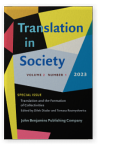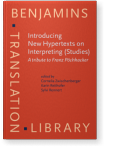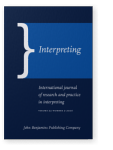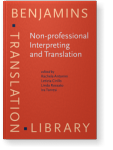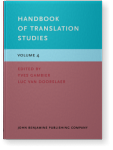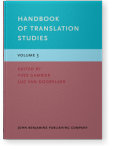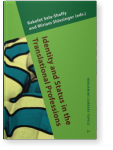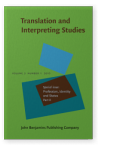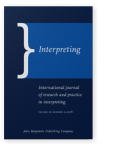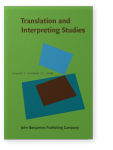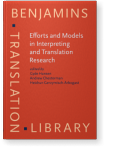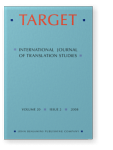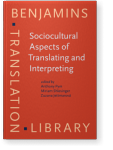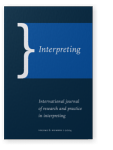Nadja Grbić
List of John Benjamins publications for which Nadja Grbić plays a role.
Online Resource
E-ISSN 1877-962X
Journal
2023 The institutionalisation of sign language interpreting in Austria and its impact on the construction of the deaf world: A social worlds perspective Translation and the Formation of Collectivities: Special issue of Translation in Society 2:1 (2023), Dizdar, Dilek and Tomasz Rozmysłowicz (eds.), pp. 33–52 | Article
Translation and Interpreting Studies research has traditionally drawn on progress models to describe professionalisation processes. In this paper, I will argue that an alternative approach based on two processual concepts, namely Anselm Strauss’s ‘social worlds’ (1978) and Thomas Gieryn’s… read more
2023 Who is an interpreter? Introducing a flexible map of translation and interpreting phenomena Introducing New Hypertexts on Interpreting (Studies): A tribute to Franz Pöchhacker, Zwischenberger, Cornelia, Karin Reithofer and Sylvi Rennert (eds.), pp. 148–167 | Chapter
Although so-called ‘non-professionals’ are no longer instrumentalised in research solely in order to compare and contrast them with ‘professionals’, this does little to change the lasting perception of two clearly demarcated categories. Such a differentiation may be meaningful in some contexts,… read more
2017 Chapter 11. Beyond the professional scope? Sign language translation as a new challenge in the field Non-professional Interpreting and Translation: State of the art and future of an emerging field of research, Antonini, Rachele, Letizia Cirillo, Linda Rossato and Ira Torresi (eds.), pp. 213–229 | Chapter
Traditionally, research on interlingual occurrences of sign language has focused on sign language interpreting. However, social practice has changed, not least as a result of the development in communication technologies and the increasing accessibility of audiovisual media. In this context, sign… read more
2013 Bibliometrics Handbook of Translation Studies: Volume 4, Gambier, Yves and Luc van Doorslaer (eds.), pp. 20–24 | Article
2012 Common grounds in Translation and Interpreting (Studies) Handbook of Translation Studies: Volume 3, Gambier, Yves and Luc van Doorslaer (eds.), pp. 7–16 | Article
2011 "Boundary work" as a concept for studying professionalization processes in the interpreting field Identity and Status in the Translational Professions, Sela-Sheffy, Rakefet and Miriam Shlesinger † (eds.), pp. 247–262 | Article
2010 “Boundary work” as a concept for studying professionalization processes in the interpreting field Profession, Identity and Status: Translators and Interpreters as an Occupational Group: Part II: Questions of role and identity, Sela-Sheffy, Rakefet and Miriam Shlesinger † (eds.), pp. 109–123 | Article
“Boundary work” is a concept that was introduced by Thomas Gieryn in the early 1980s in order to study the construction of differences between “us” and “them.” Although it was used in the first instance to study the rhetorical construction of differences between science and non-science, boundary… read more
2008 Review of Roy (2006): New approaches to interpreter education Interpreting 10:2, pp. 265–270 | Review
2008 Constructing interpreting quality Interpreting 10:2, pp. 232–257 | Article
The issue of quality has attracted considerable attention recently in translation and interpreting studies. Few publications, however, seek to explore systematically the theoretical implications of the different notions of quality. The aim of this paper is to explore quality as a social construct… read more
2008 To count or not to count: Scientometrics as a methodological tool for investigating research on translation and interpreting Translation and Interpreting Studies 3:1/2, pp. 87–146 | Article
This paper discusses various different methods and tools of scientometrics, the way in which these can be used in translation and interpreting (T/I) studies and how T/I studies might benefit from such an approach. The authors outline both the potentials and pitfalls of such studies and discuss a… read more
2008 An author-centred scientometric analysis of Daniel Gile's œuvre Efforts and Models in Interpreting and Translation Research: A tribute to Daniel Gile, Hansen, Gyde, Andrew Chesterman and Heidrun Gerzymisch-Arbogast (eds.), pp. 3–24 | Article
The article begins with a quantitative scientometric study of Daniel Gile’s published writings. The study focuses on the diachronic development of Gile’s writings and several other aspects of his scientific oeuvre such as types of publications; languages of publication; media of publication;… read more
2008 Counting what counts: Research on community interpreting in Germanspeaking countries—A scientometric study Target 20:2, pp. 297–332 | Article
This paper presents the results of a study on research on spoken and signed language community interpreting (CI) in German-speaking countries (Austria, Germany, German-speaking regions of Switzerland). A set of different scientometric, network analytical and text linguistic (keyword analysis, title… read more
2006 From 10-minute wedding ceremonies to three-week spa treatment programs: Reconstructing the system of sign language interpreting in Styria Sociocultural Aspects of Translating and Interpreting, Pym, Anthony, Miriam Shlesinger † and Zuzana Jettmarová (eds.), pp. 201–214 | Article
The practice of sign language interpreting in Austria has undergone dramatic changes since 1996. Interpreters have attended further education courses, founded an Interpreter Association, and started to work on systematically defining their profession. However, we still do not know much about the… read more
2004 Applying language skills to interpretation: Student perspectives from signed and spoken language programs Interpreting 6:1, pp. 69–100 | Article
Interpreter Education Programs (IEPs) frequently encounter a dilemma when attempting to assist students who have completed a second-language learning sequence in their transition to interpreter education. Typically, students exhibit difficulties making this transition when they perceive their… read more

